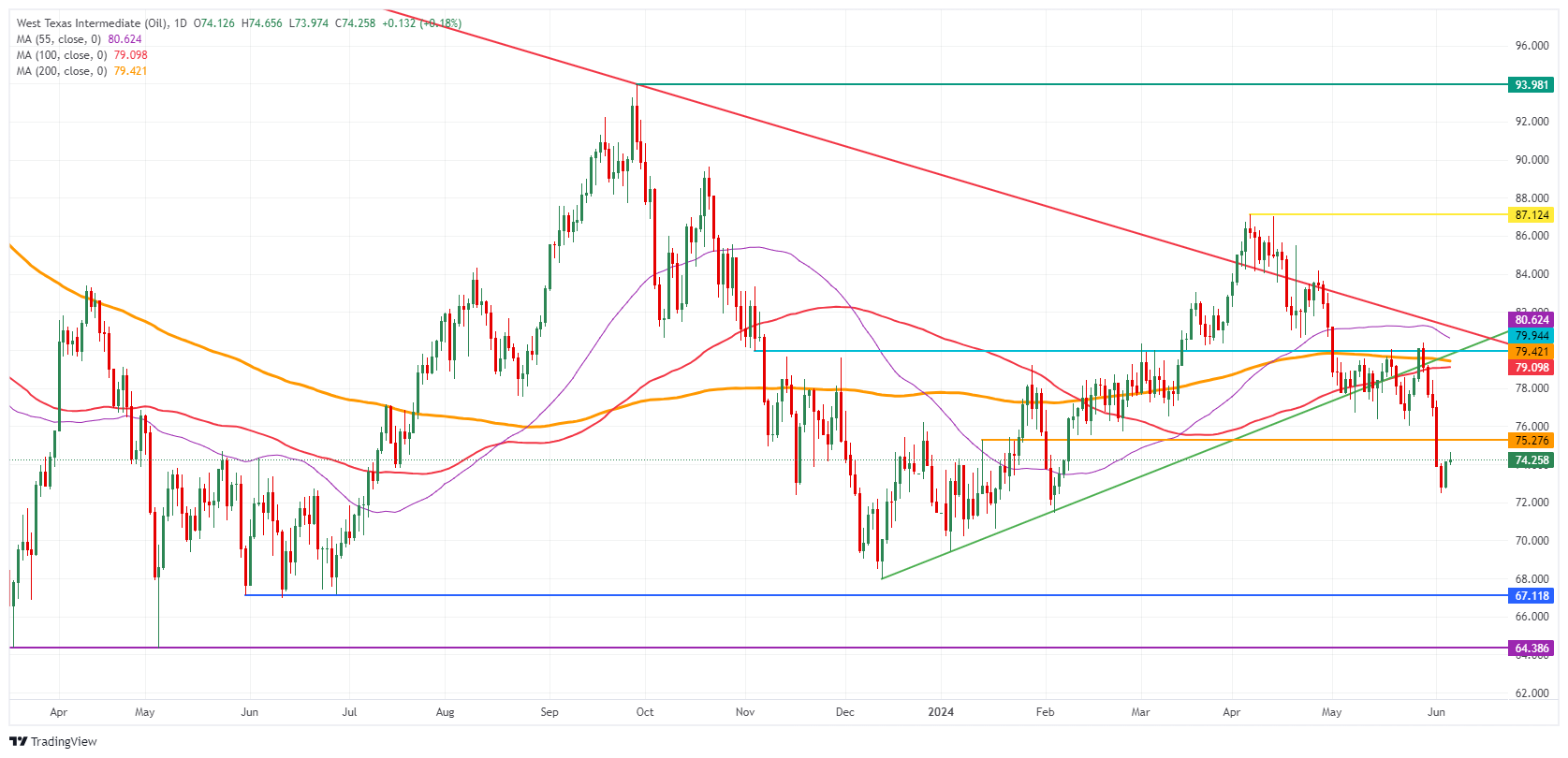Oil steady in the green with a better growth outlook projected after ECB's rate cut
- Oil ticks up, above $74.00 after a sizeable decline in the first part of the week.
- OPEC+ pushes against the bearish outlook, warning about the possibility of unwinding the taper of voluntary cuts.
- The US Dollar Index trades just above 104.00 as ECB decision looms.
Oil prices are in repair mode on Thursday after a near 10% decline in just five trading days. The sharp downside move came after the OPEC+ meeting did not hold any measure to further support prices at or around $80.00. With markets disappointed, several central banks added fuel to the fire by suggesting that an aggressive cutting cycle might not take place as disinflation is going too slow. The sell-off in the past days has prompted a response from OPEC+, which said that the organization is ready to do more to support prices when needed.
Meanwhile, the US Dollar Index (DXY) is hovering just above 104.00 after Monday’s downbeat economic data pushed the Greenback to the lower end of the 104.00-105.00 range. With the European Central Bank (ECB) interest-rate decision on the docket for this Thursday and the US Employment Report on Friday, the DXY might be trading in a new range by the closing bell at the end of the week.
At the time of writing, Crude Oil (WTI) trades at $74.36 and Brent Crude at $78.78
Oil news and market movers: ECB and Fed could control demand
- Saudi Energy Minister Prince Abdulaziz bin Salman reiterated that the OPEC agreement from Sunday, like every other OPEC+ deal, retains the option to pause or reverse production changes if necessary, Bloomberg reported.
- Citigroup upgraded its outlook forecast on the back of comments from OPEC+, forecasting that the organization might extend their output caps towards the end of the first half of 2025.
- The Citigroup report also forecasts that Oil prices might fall to $70 in 2H 2024 and to $60 per barrel in 2025 if OPEC does not change its production levels.
- Some help for Oil prices could come as US Federal Reserve Funds futures pricing data projects a rate cut in September. Lower interest rates could spark demand for Oil again, Reuters reports.
Oil Technical Analysis: Buy the dip
Oil prices are still depressed following their near 10% slide lower. The decline is driven by the fact thatOPEC+ is unable and reluctant to take more measures to limit production. It looks increasingly clear that Oil demand will largely depend on what big central banks do as an interest-rate cut cycle wouldspark an economic rally, which will support Oil demand.
Looking up, the pivotal level near $75.27 needs to be recovered first before aiming for the key Simple 100-day and 200-day Simple Moving Averages (SMA) at $79.09 and $79.42, respectively. Next, the 55-day Simple Moving Average (SMA) at $81.13 and the descending trendline at $81.45 are an area with a lot of resistance where any recovery rally could pause. Once broken through there, the road looks quite open to head to $87.12.
The $76.00 marker is now a resistance with the $75.27 level playing a crucial role if traders still want to have an option to head back to $80.00. Risks are skewed towards another leg lower, all the way down to $68.00, below $70.00.

US WTI Crude Oil: Daily Chart
WTI Oil FAQs
WTI Oil is a type of Crude Oil sold on international markets. The WTI stands for West Texas Intermediate, one of three major types including Brent and Dubai Crude. WTI is also referred to as “light” and “sweet” because of its relatively low gravity and sulfur content respectively. It is considered a high quality Oil that is easily refined. It is sourced in the United States and distributed via the Cushing hub, which is considered “The Pipeline Crossroads of the World”. It is a benchmark for the Oil market and WTI price is frequently quoted in the media.
Like all assets, supply and demand are the key drivers of WTI Oil price. As such, global growth can be a driver of increased demand and vice versa for weak global growth. Political instability, wars, and sanctions can disrupt supply and impact prices. The decisions of OPEC, a group of major Oil-producing countries, is another key driver of price. The value of the US Dollar influences the price of WTI Crude Oil, since Oil is predominantly traded in US Dollars, thus a weaker US Dollar can make Oil more affordable and vice versa.
The weekly Oil inventory reports published by the American Petroleum Institute (API) and the Energy Information Agency (EIA) impact the price of WTI Oil. Changes in inventories reflect fluctuating supply and demand. If the data shows a drop in inventories it can indicate increased demand, pushing up Oil price. Higher inventories can reflect increased supply, pushing down prices. API’s report is published every Tuesday and EIA’s the day after. Their results are usually similar, falling within 1% of each other 75% of the time. The EIA data is considered more reliable, since it is a government agency.
OPEC (Organization of the Petroleum Exporting Countries) is a group of 13 Oil-producing nations who collectively decide production quotas for member countries at twice-yearly meetings. Their decisions often impact WTI Oil prices. When OPEC decides to lower quotas, it can tighten supply, pushing up Oil prices. When OPEC increases production, it has the opposite effect. OPEC+ refers to an expanded group that includes ten extra non-OPEC members, the most notable of which is Russia.